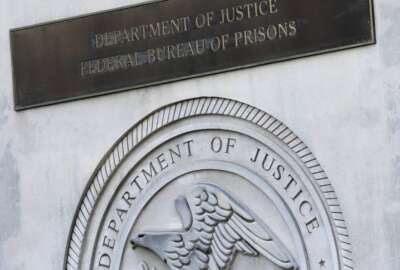
Hubbard Radio Washington DC, LLC. All rights reserved. This website is not intended for users located within the European Economic Area.
Hubbard Radio Washington DC, LLC. All rights reserved. This website is not intended for users located within the European Economic Area.
he Bureau of Prisons, an agency of the Justice Department, made two highly visible lists within couple of weeks. It placed at the very bottom of the list of Bes...
The Bureau of Prisons, an agency of the Justice Department, made two highly visible lists within couple of weeks. It placed at the very bottom of the list of Best Places to Work in the Federal Government, meaning its employees rank it as the worst place. And, it joined the three dozen other programs on the Government Accountability Office’s High Risk List. For why it made the High Risk List, the Federal Drive with Tom Temin spoke with GAO’s Director of Homeland Security and Justice Issues, Gretta Goodwin.
Interview transcript:
Tom Temin And when we last spoke, we discussed the Bureau of Prisons’ issue with preventing recidivism in operating that program, which is something that Congress mandated them to do. But now we learned the management problems are much more widespread. What got them on the list this year?
Gretta Goodwin So back in March of 2021, we identified the management of the federal prison system as an emerging issue for our high risk list. And that means that it requires close attention. So we did that for three reasons. The first reason is we had some concerns about the management of staff and resources. BOP continues to face challenges managing their staff and resources. For example, in terms of their staff, they have had staffing challenges over the years and that means they’ve had to either have their correctional officers do overtime or augment. And so that has the potential to put prisoner safety and staff safety at risk. So management of their staff and resources was one of the reasons. A second reason that we listed BOP on the high risk list is because we’ve seen and observed that they’ve had some challenges also planning for new programs or initiatives that might help people who are incarcerated prepare for successful return to the community. And so we also have provided you know, we did a report last year looking at how well BOP was helping inmates with getting ID documents when they are returning to the community. And as you know, you need an ID to get a job, you need an ID to rent an apartment. So these programs or initiatives that would help a person who is incarcerated successfully return to the community, over the years, we’ve noticed that BOP has struggled with that. We’ve also reported on BOP has had some challenges monitoring and evaluating the programs that they are offering people who are incarcerated. And so we’ve had some concerns about, you know, the spending around that. And in terms of what programs that might be made available, like, there are a lot of recidivism reduction programs that just haven’t been evaluated, that haven’t been monitored. So BOP doesn’t really have a good sense for how effective they are.
Tom Temin Right. And I think the first two might be related to the correctional officer overtime, the staffing problems and the documenting and helping people get out of prison and have good programs while they are there to rehabilitate them. Because if the staff is short, there’s a greater chance of violence and unrest in prisons. And when that occurs, people kind of get knocked down a peg in the security point and they get further from rehabilitation and release and so on.
Gretta Goodwin Yeah. And so it builds on itself. And so when we added the management of federal prison system to the high risk list, we’re also asking that BOP focus its attention on the root causes of these matters. Over the years we’ve made a number of recommendations. We still have more than 20 that are outstanding. And so we’re asking that BOP turn its attention to these issues.
Tom Temin As I spoke last week with Mr. Dodaro, Gene Dodaro, the comptroller, about, in general, the high risk list we agree that are two issues here. One sometimes is simply money. Do agencies have what they need to do, have the resources financially, they need to get off the high risk list or to improve things? And then there’s the managerial skill and quality, which is not really necessarily a money issue. It seems like here both are at play because if you don’t have enough staff and you don’t pay them well and train them well, especially in something so difficult and potentially dangerous, life threatening as being a prison guard, then you’re never going to get anywhere.
Gretta Goodwin You know, BOP understands these issues. The comptroller general has met with the BOP director and she has voiced her commitment to addressing these issues. BOP, their budget is about eight and a half billion dollars for this current fiscal year. And so when the director is doing her strategic planning, the sense is that she will, you know, make some decisions about where those monies go.
Tom Temin We’re speaking with Gretta Goodwin. She’s director of Homeland security and Justice issues at the Government Accountability Office. So there is management then, agreement that things need to be fixed. I mean, what should be the top of the list of what they do immediately to start climbing out of the hole they’re in?
Gretta Goodwin So when the BOP director is, you know, doing her strategic planning, she will make those decisions. But, you know, the three reasons why we are putting the management of the federal prison system on the high risk list, I would think that that’s of where she would start because this management managing the staff and resources is really key. And as you know, BOP, just the staff in and of itself, BOP has also had six different directors over the past six years. Two of those directors have been acting. And so just management commitment and focus is going to be a real issue here. So our sense is that the BP director is paying very close attention. And then, as I mentioned earlier, managing some of these rehabilitation programs, just trying to have a good sense for what is successful and what isn’t, and focusing your attention and your resources on that. And then you have to monitor and evaluate these programs. We just found that that has not really been happening. And so BOP doesn’t have a good sense for which programs would actually lower the rates of recidivism. And so when you think about BOP is responsible for the care and custody of federal inmates, and part of that care in custody is helping people prepare for a successful return to the community. But if you don’t have a good sense for whether these programs are working, that’s going to be a major issue.
Tom Temin Right. And again, that gets back to the staff on hand at an individual facility, because, yes, you can’t be naive to the type of population you’re dealing with, and some of them are dangerous people. There might be a few people that are really irredeemable. But on the other hand, you can’t have people that look at them as somehow less than human. At the same time, I mean, it’s a really tough role, I would think, to be able to work in a way that enhances their ability to be redeemed, to leave and be rehabilitated, not return. But at the same time, you’ve got to deal with a very tense, often dangerous situation, in reality.
Gretta Goodwin You know, some of this speaks to the staff training, the amount of staff that you have on hand. When we did the report, looking at BOP staffing challenges, we found that they were understaffed. And if you think about, you know, this current fiscal year, BOP’s authorized staffing level is like 40,236, their actual staffing level at this point in time, because we know that BOP is in a hiring position right now. They’re at approximately 34,800 staff. So there’s a five little over 5,000 gap. And so that just means you have fewer staff on hand to help deal with the population you have, and you have fewer staff on hand just to help ensure that these programs are moving as effectively and efficiently as possible.
Tom Temin And what about the Justice Department headquarters itself? What’s your sense of how much of a concern this is up at that level?
Gretta Goodwin So we know that the Department of Justice IG did list maintaining the secure, safe and humane prison system as a top management challenge for DOJ. And so we know that there is a tension from the bigger agency, the Department of Justice. We know that there is attention to these issues at the main office.
Tom Temin I mean, in some sense, dealing with a prison population can really reflect the best and the worst of what a nation is capable of, because there are many agencies that deal with people at different levels and they have their vicissitudes. But when you’re dealing with prisoners, then it’s almost a paradox. You have to keep them in place. You’ve got to make sure they don’t escape prison and don’t commit violence and so forth while they are in prison, or financial crimes. But at the same time, you have to help rehabilitate them as human beings. And I keep returning to that theme. But the extent to which we can do that successfully as a nation kind of reflects national values.
Gretta Goodwin Well, the reason BOP is here is for the care and custody of people who are incarcerated. And part of their mission, part of their role is to help reduce the rates of recidivism, help prepare people for successful return to the community. How that is done, that will be left up to the management of the federal prison system. But we know that there is a commitment to ensuring that things are done properly. Things are done effectively. We know that there’s a commitment to ensuring that, you know, anyone who enters the federal prison system is evaluated once they come in to determine what their risk of recidivism might be. They’re evaluated once they when they enter to determine what their needs are. So BOP is responsible for providing these programs, whether they be literacy programs, whether they be anger management programs. BOP is responsible for providing that because that helps individuals return safely to the community.
Copyright © 2024 Federal News Network. All rights reserved. This website is not intended for users located within the European Economic Area.
Tom Temin is host of the Federal Drive and has been providing insight on federal technology and management issues for more than 30 years.
Follow @tteminWFED


